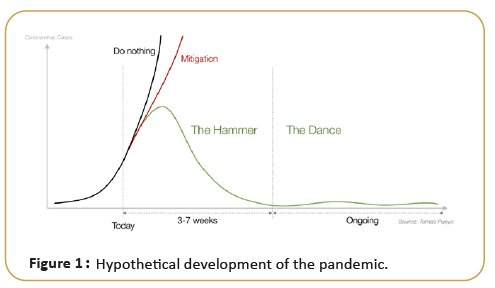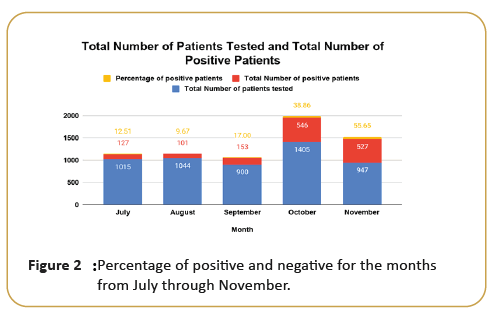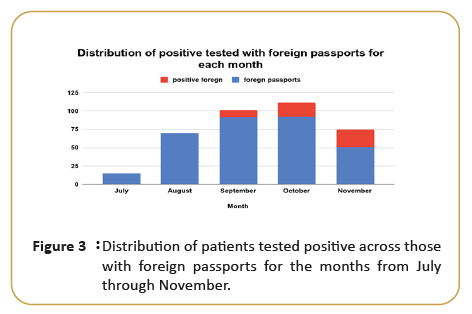Brief Report - (2021) Volume 13, Issue 10
The Epidemiological COVID-19 of rtPCR diagnostic tests for people with travel arrangements and border-crossings movement and the importance of restrictive measures, diagnostic testing and limited travels in order to contain the pandemic of COVID-19 during the summer months of 2020. The rtPCR test results were prerequisite for any planned trip and border crossings, therefore the collected data is cumulative and statistics incredibly helpful and necessary. Our Molecular Diagnostics Unit is licensed within the territory of Bulgaria. Our methods were strict protocols from the guidelines of National Center for Infectious and Parasitic Diseases-Bulgaria, the kits we use are all CE, the overall concept in sync with the global regulations as from the CDC and the WHO. We demonstrate an increase of the numbers of infected randomly tested travelers during the summer months and thereafter, giving a glimpse of the magnitude of the pandemic that followed after. We show a total increase of infection from 12.5% in July to almost 56% for the month of November.
COVID-19; SARS-CoV-2; Global pandemic; Border-crossings restrictions.
In the beginning of the year 2020 the news of the new and deadly disease broke. We only had limited information of this brand new virus from the family of the Coronaviruses; some vague specifics we had yet to discover. Swiftly it became evident, the entire world would be affected and will partake in the fight against it, as well as describing the symptoms, the major manifestations, treating patients, testing, preventing and contributing to the global knowledge in the prevention and cure[1]. We established our COVID unit testing lab within the Microbiology and Virology Division in the main County Hospital in the town of Kardzhali, Eastern Rodopi, Bulgaria[2]. Upon the beginning of our new line of work, we immediately started testing a huge amount of inpatients and outpatients as we did our best to provide prompt service, deliver results the same day, report to physicians and local health authorities for the appropriate measures and prescription of quarantine to whoever tested positive[3]. We have been working according to mandatory regulations for border crossings globally and locally and provided standard testing plus verified result certification.
Objectives
The tested patients for the months of the pandemic produced data from July to November 2020 we report, as we believe might be an important piece of evidence toward the global understanding of the spread, contagious power, significance, morbidity and mortality. We believe our data is very important for the region we live in, not only with regards to treating patients, controlling the spread and guiding the health authorities measures locally, as well as contributing to the bigger picture of understanding this new and deadly disease globally (Figure 1).

Figure 1: Hypothetical development of the pandemic.
A statistical of hypothetical development of the pandemic. According to the authors in the viral article “The Hummer and the Dance” Strong coronavirus measures today should only last a few weeks, there shouldn’t be a big peak of infections afterwards, and it can all be done for a reasonable cost to society, saving millions of lives along the way. If we don’t take these measures, tens of millions will be infected, many will die, along with anybody else that requires intensive care, because the healthcare system will have collapsed.
We base our statistical data on the results we collect directly from testing patients in our hospital on a daily basis. Our testing methods are the rtPCR for COVID19 according to the global standards of the WHO and the CDC guideline. Our methodology utilizes isolation of RNA from patient’s samples prior to the rtPCR protocol. The isolation is being done manually [4]. The rtPCR was run in the Applied Bio systems StepOne Real-Time PCR System. Our supporting methods of testing are the rapid tests with whole blood or plasma, as well as the nasopharyngeal antigen testing via swabs [5]. The reagents we use are supplied from different sources, governmental, official central supply, local grants or purchases. All of our reagents and kits are CE.
For the testing we collected data from Key dates, which include the date of onset of disease, date of admission to hospital, date of confirmation of infection, and dates of travel [6]. Demographic information about the age and sex of patients/cases. Geographic information, at the highest resolution available down to the district level [7]. We excluded information that was at the building level so that cases could not be identified. Geographic information was subdivided into administrative units. All the information collected with the results was entered into the national system for COVID for Bulgaria within the same day. Summaries of the data are shown in Figure 2. According to the data there is an increase in the patients tested positive from the beginning of the summer through July until November. During the summer months the travel across borders was achieved only with evidence of a negative PCR test (Figure 3). We recorded mainly negative and healthy individuals traveling through earlier on, but with the shift of the seasons, the patients with positive tests increased. We have no data for the objectives and the purpose of people’s travelling reasons and the need to cross borders, but we speculate the summer months were for family annual vacation, as well as business related and the need to travel back home for people with seasonal jobs throughout Europe (Table 1).

Figure 2: Percentage of positive and negative for the months from July through November.

Figure 3: Distribution of patients tested positive across those with foreign passports for the months from July through November.
| Month | Total number of patients tested | Total number of positive patients | Number of patients with foreign passports | Patients with foreign passports tested negative | Patients with foreign passports tested positive |
|---|---|---|---|---|---|
| July | 1015 | 127 | 15 | 15 | 0 |
| August | 1044 | 101 | 70 | 70 | 0 |
| September | 900 | 153 | 91 | 81 | 10 |
| October | 1405 | 546 | 92 | 73 | 19 |
| November | 947 | 527 | 51 | 28 | 23 |
Table 1: The important aspects of epidemiological data.
As our data builds further and we collect more evidence, we can report solid evidence for one very good reason for the spread of the COVID infection in regions near border crossings. For the Greek authorities to grant entrance to the citizens with Greek passports the rtPCR negative results were prerequisite. We also observe percentages of positive not by peaks, but rather steady increase in numbers. The increase of positive tests further gave an increase of morbidity and mortality (not presented), lots of patients with a need of hospitalization, exceeding the available hospital beds, excausting the hospital resources and staff. The increase in infected people exposed many doctors and healthcare workers to an immense risk on the job, a rather grave situation, just like anywhere else in the world.
As we believe our data has been collected daily and reported to local and national authorities, we continue to study the trends and nuances of the mass number of tested individuals. Although we separate and count the foreign passports in our database, we firmly believe the reason for testing is for travel across borders. We cannot tell though what percentage of the Bulgarian passport-holder healthy individuals, subjected to testing, had the intention of traveling and therefore we can only speculate, based on the data we present. However non-exact and biased the results, we think the trend shows clearly enough the evidence of spread due to people travel and movement, regardless of mechanisms of spread-via infected patients or simply mechanically disseminating the virus particles. Furthermore, the actual rtPCR protocol as such, there is a considerable amount of wait before the results become available, so simply we have no control over the patients physical contacts during that time; the time they spend at the local grocery store or a restaurant, the lingering at the actual hospital and the like. Based on our evidence, we can make a suggestion that we observe a higher percentage of infected, tested positive and ultimately sick patients in the larger cities near border crossings, where the testing for SARS-Cov2 is being done.
As we experienced several complete lockdowns, followed by slight removal of restrictions we can only hope we follow the scheme outlined by the hammer and the dance. Our greatest hope is that with more and more medicinal products now available, more and more people take the advantage and can hope to be slowly moving back to normalcy. The current report represents retrospective data and suggests the possibilities, available to nations and applicable locally and of immense importance near border-crossing regions in a situation of pandemic with such magnitude and without the immediate access to vaccines and reliable treatments for brand new infectious outbreaks.
Received: 06-Oct-2021 Published: 27-Oct-2021
Copyright:This is an open access article distributed under the terms of the Creative Commons Attribution License, which permits unrestricted use, distribution, and reproduction in any medium, provided the original work is properly cited.